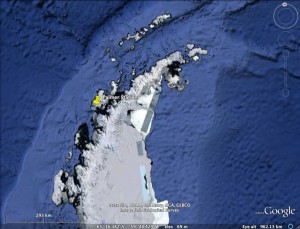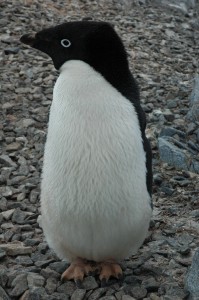
The West Antarctic Peninsula (WAP) is one of the most rapidly warming regions on Earth, with a 6°C temperature rise since 1950. Glaciers are retreating and the duration and extent of sea ice has significantly decreased. Many species rely on the sea ice as a resting platform, breeding ground, protective barrier or have life histories linked to sea ice thaw and melt cycles. With the declines in sea ice, many species are having a difficult time surviving and adapting to the new warming conditions.
The food web along the WAP is short and allows energy to be transferred efficiently. Phytoplankton (tiny plants that capture energy from the sun) are ingested by zooplankton (such as krill) which are in turn eaten by penguins, seals and whales. Due to the rapid nature of the warming around Palmer Station and the short food chain, it is an ideal location to study the effects of the acute changes in a warming environment.
In particular, Adélie penguins are experiencing significant population declines near Palmer Station, Antarctica. On Anvers Island, populations have decreased by 70%. Declines in sea ice have also led to declines in the preferred food of Adélies. Silverfish have nearly disappeared and krill have decreased by 80%. Currently, Adélies are having a difficult time finding a satisfying meal. In turn, many species are migrating southward to look for new places to live and better food resources. On the other hand, ice-avoiding species (Gentoo and Chinstrap penguins) have been able to move south into the Adélies home range.
Adélies are a prime vertebrate species to study in relation to a changing environment. Tagging Adélies in summer breeding colonies with satellite-linked transmitters, allow foraging locations to be monitored. Their foraging tracks can be compared to satellite derived oceanic properties such as sea surface temperature, chlorophyll, sea-ice, and wind. Since conditions have changed so quickly over the last few decades, the recent development of satellites can easily detect these changes. The UD-134 Slocum Glider (underwater robot) will be deployed in January 2011 and 2012, to do additional surveys near breeding hotspots. This will allow us to combine satellite data with high resolution in-situ glider data to predict how ideal foraging locations for Adélies may change as warming continues. This will also test the satellites ability to accurately describe ecological changes that are occurring along the WAP.
The Palmer Long Term Ecological Research Program (PAL LTER) began in 1990, and investigates aspects of this polar environment while maintaining historical records for marine species. Historical satellite data and species records will be useful in predicting phytoplankton, krill and penguin abundances and distributions. Models will be used to predict future foraging locations of Adélies in PAL LTER region of the WAP. It is important to study this region because changes are happening faster than predicted and these changes can lead to dramatic effects in our lifetimes.


